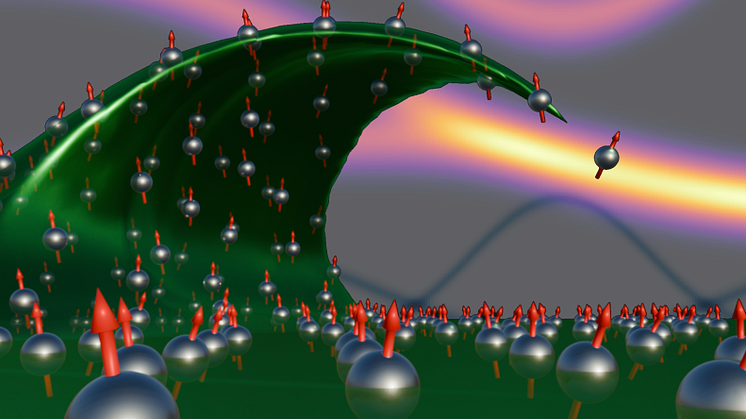
Press release -
Seeing Spins Dance at the Nanoscale
For the first time, spin waves also known as magnons, have been directly observed at the nanoscale. This breakthrough was made possible by combining a high–energy-resolution electron microscope with a theoretical method developed at Uppsala University. The results open exciting new opportunities for studying and controlling magnetism at the nanoscale.
“We could suddenly see all the magnons and every step of their dance at the nanoscale! Until now, only surface magnons had been glimpsed at this resolution. It was like getting front-row seats to a performance no one had ever seen in full,” says José Ángel Castellanos-Reyes, co-first author of the study and researcher at Uppsala University.
The magnetism of materials such as iron and nickel is a consequence of “tiny magnets” attached to their atoms, so-called atomic spins. In these magnetic materials, the spins in different atoms dance together in a synchronized motion called spin waves or magnons.
Magnons play a key role in the rapidly growing research field of magnonics, where the spin waves are used to carry information instead of electric charges. Magnonics has the potential to drive the next generation of electronics, offering faster, smaller, and more energy-efficient technology compared to today’s charge-based systems.
Despite their importance, magnons have been nearly impossible to observe at the nanoscale with existing technologies. A big challenge in magnonics is understanding how magnons behave and how their properties may be modified at the nanoscale. For example, until now it has not been possible to assess the effect of impurities, such as a vacancy where an atom is missing in a material, on the performance of magnonic devices.
But now, in a study published in Nature, researchers from Uppsala University and international collaborators, have taken a big step forward by introducing a new method to visualize and analyze magnons at the nanoscale. This was possible thanks to the combination of experiments performed at SuperSTEM laboratory in the UK and two theoretical and computational methods developed at Uppsala University, TACAW and UppASD.
In the experiments, the researchers used a scanning transmission electron microscope (STEM) with extremely high energy resolution, around 7 meV, available in only a few instruments worldwide. They measured energy losses in the electron beam as it passed through the sample, revealing subtle traces of magnons.
One of the methods used in the study is the Time Autocorrelation of Auxiliary Wavefunctions (TACAW), a theory for high–energy-resolution electron microscopy. TACAW was created and developed at Uppsala University by José Ángel Castellanos-Reyes together with Paul Zeiger and Ján Rusz, and allowed the researchers to simulate how magnons interact with fast-moving electrons. Their calculations helped to identify the faint magnon signals in the experiment.
“We predicted to find a magnon signal at an energy of around 100 meV in the nickel oxide nanocrystal, and the experiment confirmed it,” says Ján Rusz, professor at the Department of Physics and Astronomy, Uppsala University.
The other crucial method is UppASD, an open-source software for atomistic spin dynamics, developed and maintained at Uppsala University. It was decisive to simulate the magnons of nickel oxide, the model system used in the experiments.
“UppASD is an established method for simulating magnons that can be detected with other experimental techniques. Thus, we are very pleased to see that it also played a key role in this new type of experiment”, says Associate Professor Anders Bergman and developer of UppASD.
The study shows that it is now possible to see how magnons behave at the nanoscale and could change how we understand magnetic materials.
“This is a milestone in magnonics and microscopy! It opens exciting opportunities for the development of spin-based electronic devices,” says José Ángel Castellanos-Reyes.
About the study
The study was made in a collaboration between Uppsala University, SuperSTEM laboratory, University of York, University of Leeds, Durham University, Pacific Northwest National Laboratory, and Washington University.
The experiments were carried out at SuperSTEM laboratory (UK) and led by Demie Kepaptsoglou. The theoretical work was carried out by José Ángel Castellanos-Reyes with contributions from Paul Zeiger, Anders Bergman, Ján Rusz (UU), Adam Kerrigan, J. A. do Nascimento (University of York, UK), and Buddhika Mendis (Durham University, UK).
Funding
The Swedish part of the study was funded by the Swedish Research Council (grant no. 2021-03848), Olle Engkvist’s foundation (grant no. 214-0331), STINT (grant no. CH2019-8211), Knut and Alice Wallenberg Foundation (grant no. 2022.0079), and eSSENCE.
The simulations were enabled by resources provided by the National Academic Infrastructure for Supercomputing in Sweden (NAISS), partially funded by the Swedish Research Council through grant agreement no. 2022-06725.
TACAW
TACAW was developed by José Ángel Castellanos-Reyes, Paul Zeiger, and Ján Rusz at the Department of Physics and Astronomy at Uppsala University. The method’s name, pronounced "Taco," is a nod to the famous Mexican dish.
https://link.aps.org/doi/10.11...
UppASD
UppASD is a software suite for studies of magnetism and magnetization dynamics on the atomic scale. The name UppASD is an acronym for Uppsala Atomistic Spin Dynamics, and the method has been mainly developed at the Department of Physics and Astronomy at Uppsala University.
UppASD: https://github.com/UppASD/UppA...
Article reference
D. Kepaptsoglou, J. Á. Castellanos-Reyes, A. Kerrigan, J. A. do Nascimento, P. M. Zeiger, K. El hajraoui, J. C. Idrobo, B. G. Mendis, A. Bergman, V. K. Lazarov, J. Rusz, Q. M. Ramasse. "Magnon spectroscopy in the electron microscope," Nature (2025). DOI: https://doi.org/10.1038/s41586...
Previous study
New Theory to Explore Atomic and Magnetic Vibrations at the Nanoscale, https://www.uu.se/en/departmen...
Contact
Ján Rusz, Professor at the Department of Physics and Astronomy, Uppsala University, jan.rusz@physics.uu.se +46 70-167 93 76
José Ángel Castellanos-Reyes, researcher at the Department of Physics and Astronomy, Uppsala University, angel.castellanos@physics.uu.se
Anders Bergman, Associate Professor at the Department of Physics and Astronomy, Uppsala University, anders.bergman@physics.uu.se +46 70-425 05 88
Paul Zeiger, Post doc at the Department of Physics and Astronomy, Uppsala University, paul.zeiger@physics.uu.se +46 70-404 13 63
Topics
Categories
Founded in 1477, Uppsala University is the oldest university in Sweden. With more than 50,000 students and 7,500 employees in Uppsala and Visby, we are a broad university with research in social sciences, humanities, technology, natural sciences, medicine and pharmacology. Our mission is to conduct education and research of the highest quality and relevance to society on a long-term basis. Uppsala University is regularly ranked among the world’s top universities. www.uu.se
